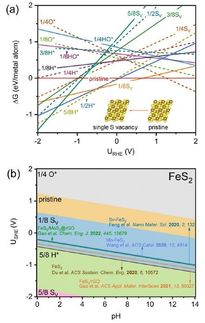Researchers reveal multi-path mechanism in electrochemical CO2 reduction
Advertisement
A research group led by Prof. XIAO Jianping from the Dalian Institute of Chemical Physics (DICP) of the Chinese Academy of Sciences (CAS) and their collaborators synthesized a single-atom Pb-alloyed Cu catalyst (Pb1Cu), which showed high activity for the electrochemical CO2 reduction reaction (CO2RR) with a selectivity of 96% to formate and stability of up to 180 h at 100 mA cm-2.

Researchers reveal multi-path mechanism in electrochemical CO2 reduction
DICP
The researchers reported multi-path for CO2 reduction to formate, namely the reaction paths through COOH* and HCOO* intermediates. The reaction phase diagram was built based on the "energy global optimization" approach, describing the activity trend for CO2RR to formate. A double-peak activity trend was obtained owing to the consideration of multi-path.
They found that Cu preferred the COOH* path, resulting in the production of hydrocarbons and oxygenates, which exhibit limited selectivity and activity toward a specific product. However, Pb1Cu preferred the HCOO* path. The optimal HCOO* binding energy in Pb1Cu revealed either high activity or selectivity to formate via CO2RR. The agreement between experimental and theoretical activity trend confirms the reliability of multi-path mechanism.
The Cu site on the Pb1Cu step surface, rather than the single-atom Pb site, showed the highest CO2RR activity toward exclusive formate production. The free-energy diagram with the calculated electrochemical barriers also confirms the formate selectivity.
"The 'double-peak' describes a more accurate activity trend for CO2RR, providing a significant insight for catalyst design," said Prof. XIAO.
Original publication
Most read news
Other news from the department science

Get the chemical industry in your inbox
By submitting this form you agree that LUMITOS AG will send you the newsletter(s) selected above by email. Your data will not be passed on to third parties. Your data will be stored and processed in accordance with our data protection regulations. LUMITOS may contact you by email for the purpose of advertising or market and opinion surveys. You can revoke your consent at any time without giving reasons to LUMITOS AG, Ernst-Augustin-Str. 2, 12489 Berlin, Germany or by e-mail at revoke@lumitos.com with effect for the future. In addition, each email contains a link to unsubscribe from the corresponding newsletter.


























































